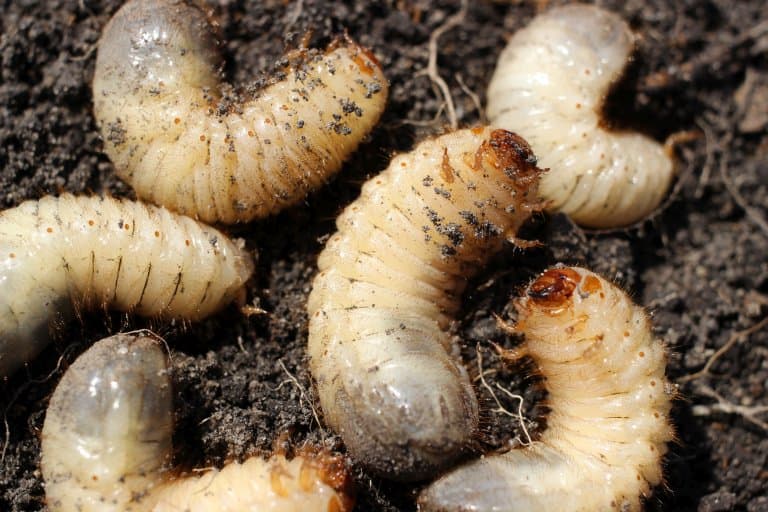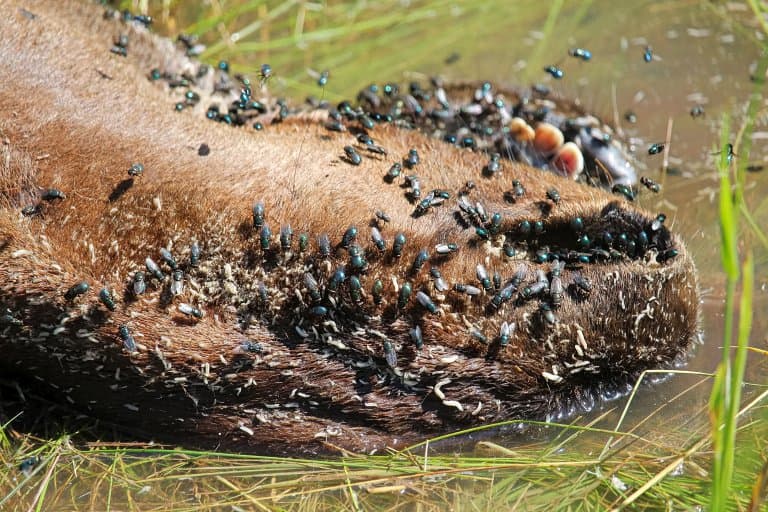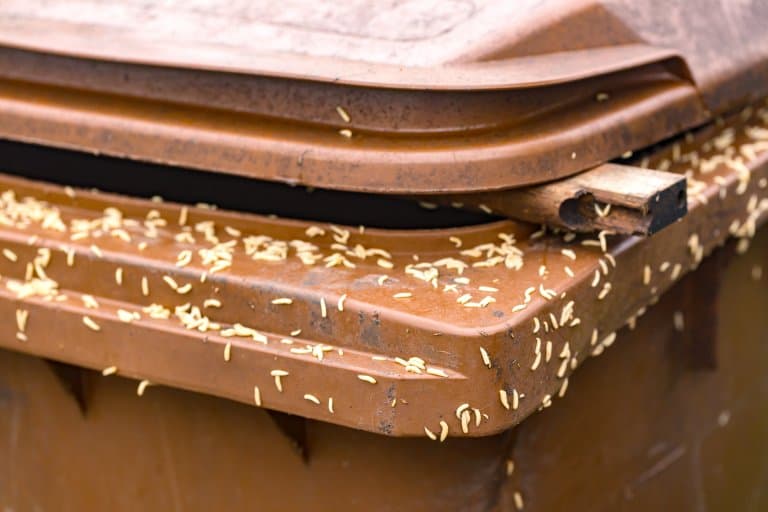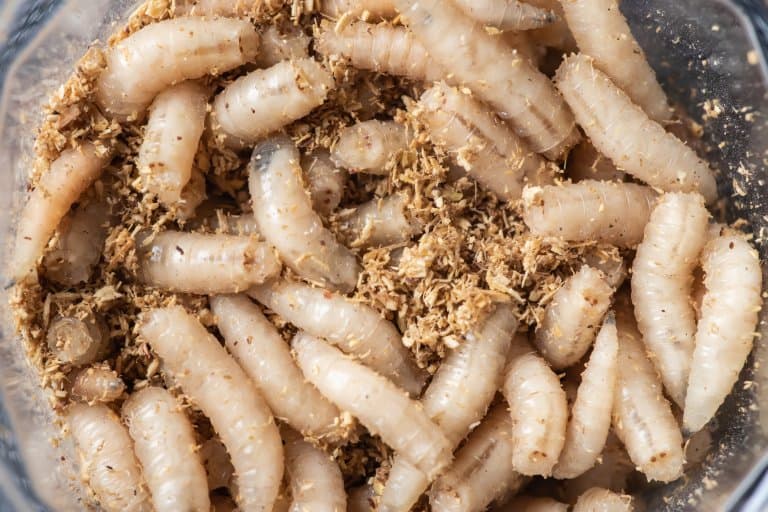Maggot Profile
Maggots have a powerful place in our subconscious.
Their movement; their association with rotting flesh and dangerously over-ripe food; the fact that they spawn about a billion flies… there’s a lot in our biology that tells us we don’t want to be anywhere near them.
But what exactly is a maggot? How does it live, and what does it think of its existence? Let’s find out.

Maggot Facts Overview
| Habitat: | Decaying matter |
| Location: | Worldwide |
| Lifespan: | Days to years |
| Size: | Microscopic to around 5cm (2 inches) |
| Weight: | Usually <1g |
| Colour: | Usually grey/brown |
| Diet: | Detritus, decaying matter, sometimes live animals |
| Predators: | Almost everything |
| Top Speed: | Slow |
| No. of Species: | Thousands, maybe hundreds of thousands |
| Conservation Status: | N/A |
Maggots are usually what happens between an egg and an adult fly, and despite their appeal, they are exceptionally useful animals. At least, in most cases.
Sometimes they’ll eat your skin and burrow into your flesh, but for the most part, they’re on our side.
They’re used to great success in the field of forensic pathology, but they can sometimes act as a biocontrol for livestock too.
Their major benefit, though, comes in getting rid of all our corpses and food waste.
Interesting Maggot Facts
1. It’s a baby fly
Maggots make up any fly larva that, well, looks like a maggot. It’s not a strict term, but it typically applies to the soft-bodied, caterpillar-like larvae of various forms of fly.
Flies are any member of the Diperan order, and many, if not most, reproduce with a larval stage that represents a sort of thick, rubbery worm with no legs.
They’re usually differentiated from other fly larvae like mosquitos or similar, that have a more active stage or ones with limbs but again, it’s not a strict definition.
In some cases, any insect larva is referred to as a maggot.

2. But they do have common traits
One thing that typically sets maggots aside from their legged or tailed equivalents is their penchant for eating trash. This might be dead animals or plants, fruit, or rotting meat from an open wound; maggots are usually well-designed for worming their way through detritus.
As gross as this sounds (and is) this makes them unspeakably important to the ecosystem as nutrient recyclers and as disease reduction agents.
3. They’re good detectives
Maggots are commonly used in forensic pathology, as they occupy a corpse at a reliable schedule and grow at a predictable rate.
A time of death can be very accurately inferred by the amount and stage of the maggot infestation on a body.
Maggots are efficient munchers that can begin work within 15 minutes of you popping your clogs. By the time there are 5,000 of them, they can eat through half a refrigerated body in just three or four days. 1

4. They can also pick up drugs
Another post-death assessment via the local cleanup crew comes in the form of drug testing. While the presence of maggots can determine the time of death to an accuracy of around a day, it’s a short-term measure.
After a while, too many generations of maggots will be present and the body too decayed to use that accurately. However, many chemical enhancers that the ex-human may have taken bioaccumulate in the maggot population, meaning they can be accurately tested for drugs long after death.
This is one of the major ways to determine what kind of drugs were present in the person’s system when they died. 2
5. They also help the living
While a maggot-infested open wound sounds almost worse than an amputation, their preference for dead flesh makes maggots a useful topical solution to some medical cases.
Maggot therapy is a medieval yet effective treatment for necrotic wounds that involves bandaging up a bunch of baby maggots and letting them go to town on the decaying parts.
The maggots will leave all healthy matter alone and focus only on the rotting parts, reducing the risk of infection and preventing necrotic spread caused by bacteria in the dead tissue.
(Of course, you can blend them up afterwards to make some necrotic spread if you want).
The maggots used in this therapy are bred for the purpose and disinfected, so they’re not picked off a corpse and strapped to a wound, but the wriggling must take some getting used to, especially since the therapy can take days or weeks to complete. 3 4
6. They do cause harm too
Maggots are possibly the most under-appreciated biological aides we have. Their disgusting movement and all that corpse-eating have given them a bad reputation, but on the whole, they’re invaluable ecosystem engineers.
However, they do live in poo and rotting meat and all that lovely stuff, so they can also be disease vectors. Or, even worse, myiasis.
This is a word you probably don’t want to look up on Google.
Some maggots are capable of infesting live tissue. In places where certain species proliferate in bins or unsanitary conditions, there can be a risk that a handful will jump ship and parasitise a healthy person.
This is especially the case with certain species of maggots that are specifically evolved to be parasites. Mango flies, bot flies, and blowflies, to name a few.
Again, Google this at your peril. 5

7. Some are even hunters
Other species are predatory. At least one blowfly sires countless maggot-hunting larvae that look like a hotdog that’s been rolled across a dirty carpet.
These bristly maggots allow other fly larvae to do all the work of munching on rotting organic matter and then eat them to save time.
As gross as this is, some are actually great as a biocontrol against some of those myiasis-causing fly species, as they act as a natural predator and reduce their numbers. This has varied degrees of effect against common livestock pests that burrow into the skin of sheep and cattle, for example. 6
8. They are a fishermans friend
Maggots are the most popular bait used by anglers across Europe to catch non-predatory fish. They are also used in North America, primarily as ice fishing bait.
Artificial maggots which in florescent colors have also been produced that are used to catch trout and salmon!

Maggot Fact-File Summary
Scientific Classification
| Kingdom: | Animalia |
| Phylum: | Arthropoda |
| Class: | Insecta |
| Order: | Diptera |
| Family: | 200+ |
Fact Sources & References
- (2023), “Maggots and barnacles at the murder scene: forensic entomologists’ best friends”, Cosmos.
- Dr. Gail S. Anderson, “FORENSIC ENTOMOLOGY : THE USE OF INSECTS IN DEATH INVESTIGATIONS”, Simon Fraser University 8888 University Drive Burnaby, B.C.
- Amelia Tait (2023), “Medieval medicine: the return to maggots and leeches to treat ailments”, The Guardian.
- Iran J Parasitol (2021), “Using Maggot Debridement Therapy in Treatment of Necrosis in the Forearm Caused By Docetaxel Extravasation: A Case Report”, NIH.
- “Parasitic Flies (Tachinid Flies)”, Missouri Dept. of Conservation
- “Hairy Maggot Blow Fly”, iNaturalist.
